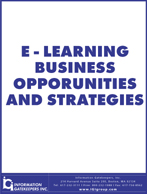|
|

 |
|
Overview:
E-Learning technology is rapidly expanding the market for eduaction products and services to working profesionals, consumers, and investors. That is one of the conclusions of the new 89-page report, E-Learning Business Opportunities & Strategies.
"E-Learning is poised for explosive growth in new markets," said Dr. Dirk W. Rudolph, one of the three e-learning experts contributing to the report. "E-learning delivers powerful solutions for a continuum of application- form traditional education for non-traditional students to knowledge sharing for sales, public relations, and workgroup collaboration," he added.
"This report explains how networks will multiply the success of quality learning content, " said Ira Broadsky, President of datacomm Research. "It explains how digital content can be repackaged for different market segments, how courses that might fail locally can prosper gloabally, and how intranets and wireless networks can extend on-line courses to some of the most highly motivated learners," he concluded.
E-Learning Opportunities & Strategies includes an Executive Summary identifying the best business opportunities by market segment, woprld region, and time frame. The Market Strategies secion discusses the imact of content aggreagators, free courseware, customization, and" versioning." The markets are evolving in unexpected direction. The Enabling Technologies section looks at opportunities for exploiting virtual private networks (VPNs), wireless LANs, and emerging mobile learning (m-learning). the report also profiles more than 30 vendors and contains a number of case studies.
The report's authors. Joachim P. Hasebrook, Dirk W. Rudolph, and J. Udo Steffens, have extensive experience developing e-learning slutions. their e-learning business activities have been funded by leading German banks BHF Bank, Dresder Bank, Deutsche Bank, and Bankakademie E.V.
Additional Conclusions Found In E-Learning Business Opportunities & Strategies:
1. Wirelss LANs will enable K-12 schools, colleges, and universities to provide a range of enhanced services for students, faculty, and administrators. In K-12 schools, wireless LANs facilitate use of PCs and the internet in classrooms and labrotories that lack network wiring. on campuses, wireless LANs permit mobile access to a vaiety of resources (such as online libraries) from laptob PCs and PDAs.
2. Third generation wireless will enable mobile learning (m-learning). new education and training opportunities, serving busy professionals who don't have time to attend classes, will emerge. Third generation wireless will also spawn development of courses designed for "bursty" learning.
3. Digital rights management (DRM) will be used not only to protect content but also package it for specific market segments. DRM technology was primarily developed to prevent unauthorized acccess and redistibution, but can be employed to create targeted versions at different prices for specific custiomer groups. Thus, a quick refresher course that expires in two weeks could be offered at a low-cost.
4. E-books have not experienced mass-market success. however, they are the perfect fit for certain e-learning markets. E-books simplify distribution of the latest versions of service manuals and catalougues. they also enable non-traditional students and field workers to carry entire reference libraries in a small and lightweight package.
TOP
|
|
|